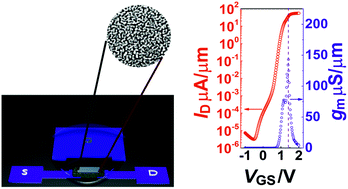Inkjet-printed co-continuous mesoporous oxides for high-current power transistors†
Abstract
Limited printing resolution has always been a major hindrance for printed electronics; irrespective of the high mobility demonstrated by solution-processed semiconductors, long-channel printed field-effect transistors (FETs) have demonstrated low On-state conductance and switching speeds. Although various concepts have been proposed to obtain narrow-channel printed FETs, the actual demonstration of high On-currents/channel conductance has been rare. In this context, herein, we report a general recipe to print co-continuous mesoporous structures with high surface-to-volume ratios for the first time for a large range of metallic and semiconducting oxides, both n- and p-type; next, by exploiting an innovative transistor architecture by printing an additional silver layer on top of the printed porous channel, we reduced the necessary length of electronic transport through the semiconductor material to a short vertical distance of the order of a few tens of nanometres. Basically, when a composite solid polymer electrolyte was used as a gate insulator, we essentially obtained channel length-independent transport with the unprecedented On-current of 67 μA μm−1 and transconductance of 143 μS μm−1 at the supply voltage of only 0.5 V. Among others, one may foresee the usage of these devices in high power switches and for drawing power from batteries in all-printed electronic circuits.



 Please wait while we load your content...
Please wait while we load your content...